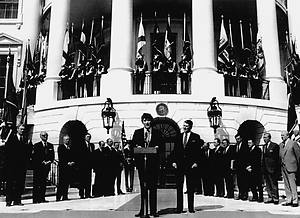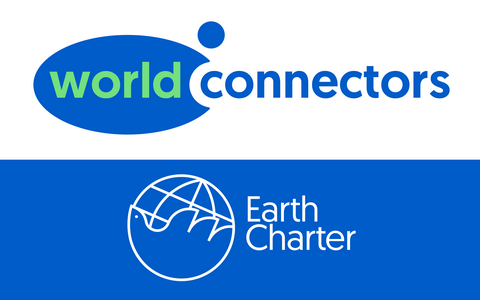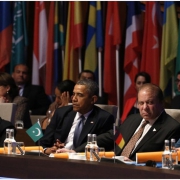Ruud Lubbers: Personal Diary Snapshots on Nuclear Security
The words below reflect the history of nuclear power in the last seven decades, through personal snapshots from Ruud Lubbers’ memory. As the former Prime Minister of the Netherlands, Ruud Lubbers shared these reflections during the pre-conference of the Nuclear Security Summit, which is currently taking place in The Hague and bringing together more than 50 world leaders to discuss the prevention of nuclear terrorism.
“While the Nuclear Summit has started in The Hague, a few snapshots out of my “nuclear” diary revived.
Born in The Netherlands, seventy five years ago, I grew up with the vivid memory that the Second World War ended in Japan with the “Atoombom” (Atom bomb). This is my first snapshot.
Nevertheless, when I as an eighteen year old boy visiting the Euratom Exhibition in Brussels, I was very positive about nuclear; its potential for human health (isotopes) and for the production of electricity. This is my second snapshot.
My third snapshot is fifteen years later. It dates 1973. I became a young Minister for Economic Affairs and Energy. Under this snapshot, forty years ago, I wrote about “The first oil crisis”. In those years, OPEC had embargoed the USA and the Netherlands. OPEC failed. It gave me an opportunity to prove to be a successful minister and politician that year and subsequently twenty one years thereafter.
My fourth snapshot is a short time later, in 1975, as the young minister that founded the Dutch Energy and Nuclear Research Center. In those days I learned that Professor Kistemaker had after the Second World War developed another technology to enrich uranium. I am talking about the now well-known gas centrifuges. Together with our German and English friends we created URENCO.
The fifth snapshot from my personal nuclear (photo)album is a remarkable one, under which I penciled Mr Kahn in 1975. He studied engineering and subsequently worked for a subcontractor, working at the company that translated Kistemaker’s findings into a profitable business, Urenco. I remember vividly the very day that at my Ministry it was said “Mr. Minister, we have detected a spy”.
As the Dutch were not allowed to look into this “security” matter, we had to leave this to American and British intelligence. The American and British intelligence considered themselves as competent and qualified in matters of security.
Frankly speaking, in the years thereafter, all the way up to the years I was Prime Minister, I became increasingly amazed that these services focused on intelligence and not on action.
That attitude has given room to the “Khan network”. Of this network I have no snapshot in my personal nuclear diary. I should have travelled to countries like North Korea, Libya, Iraq and so on to collect them. I did not.
 No, my sixth snapshot is taken in Washington DC, January 1983. It shows President Reagan and me as a young Dutch Prime Minister. I was there to talk about NATO, or more specifically the Soviet threat to “finlandize” West European countries with SS20 missilesystems. These were not meant for strategic nuclear forces but for intermediate nuclear forces.
No, my sixth snapshot is taken in Washington DC, January 1983. It shows President Reagan and me as a young Dutch Prime Minister. I was there to talk about NATO, or more specifically the Soviet threat to “finlandize” West European countries with SS20 missilesystems. These were not meant for strategic nuclear forces but for intermediate nuclear forces.
I just mentioned to “finlandise”. This expression, well known in those days, was used to indicate effective political influence without military action.
This sixth snapshot is my favourite; because there Reagan confided to me his ambition to go for zero-zero with the intermediate forces. There, in Washington, he said to me “Ruud, to get this done we have to let the commies sweat first”.
This brings me to my seventh snapshot. That is a photo of Ronald Reagan together with Michael Gorbachev in Reykjavik 1986. There they agreed on zero-zero and that was part of the beginning of the end of the Cold War.
My eighth snapshot is about Tsjernobyl. Yes, that happened the same years. After the famous Three Mile Island accident in Pennsylvania USA: again a drawback for me as a nuclear positivist – and that just before the first time that I had to be re-elected in 1986 as Prime Minister of the Netherlands. I remember vividly that my then Minister for the Environment did a great job to calm down our farmers not to become too nervous about radio-activity coming down all the way from Tsjernobyl on Dutch grasslands.
My photo album on nuclear ends too early. Otherwise it would contain the more recent tsunami disaster in Japan, which rocked the trust of the public at large in nuclear energy.
Firstly in the USA, then in Tsjernobyl and then in Japan. Every few decades I have experienced nuclear accidents. For me, a nuclear positivist, this is also part of my life.
Going back to the eighties of the last century my next snapshot is of George Bush, Vice President under Ronald Reagan. He became known as Father Bush. His son invaded Iraq to go after nuclear military capacity.
You all will recall Colin Powell, the then American Secretary of State in the U.N. Security Council, first motivating military action and then later apologizing for the wrong information.
Those days I was part of the U.N. Family, as a High Commissioner for Refugees. That gave me the opportunity to sit down with Mohamed El Baradei, in charge of the International Atomic Energy Agency in Vienna. Mohamed interviewed me about the Khan history and I used this opportunity to question him about “yes or no” nuclear capacity in Iraq ?
When I returned to the Netherlands I continued my link with El Baradei and the IAEA; the Nobel Prize winner.
My journey with nuclear went all the way from Petten and Urenco, to ten years ago, becoming sort of family of the International Atomic Energy Agency in Vienna.
My next snapshot shows three Americans; Kissinger, Shultz and Scowcroft. These “have beens” from the years of President Reagan and Father Bush created a new awareness on nuclear arms some time ago, eventually resulting in the “global zero movement” these days.
The next snapshot dates from January 2010. It shows four Dutch Ministers of State; Max van der Stoel, Hans van Mierlo, Frits Korthals Altes and myself. The two former Foreign Ministers passed away a couple of years ago already, Korthals Altes and myself are still around. The last paragraph of what this Dutch “Group of Four” published those days reads :
“The significance of the action of the first “Group of Four” (Kissinger, Nunn, Schultz and Perry) lies in the fact that during the time they held responsibilities in the government, they used the threat of nuclear weapons as a means to maintain peace. Though it is unusual, we as (Dutch) “policy veterans” consider this to be the right moment to speak out and join our former colleagues in their call for a world without nuclear weapons.”
These “alarm bells” of American and Dutch have beens as well as of similar initiatives in other NATO-members, are ringing loudly at the very same time that President Obama feels obliged to combine arms control with modernization of nuclear arms.
I use this opportunity to applaud President Obama for his effort to explore diplomacy and partnership with Iran after decades of no diplomacy at all; a sort of new Reykjavik.
My last snapshot is about Angela Merkel, the “Ossie” who succeeded Helmut Kohl. After all she is my neighbour; and immediately after the coming down of the Berlin Wall I was able to connect with her. More recently after Fukushima, she went “für die Energiewende” in Germany, phasing out nuclear energy in her country.
With all my commitment to “global zero” when we talk about nuclear weapons, I still have not lost my positive attitude towards electricity generated by nuclear technology. With all my sympathy for renewables to reduce climate change risks, I wonder whether “our common future”, which is the responsibility for generations to come and for their essential need of electricity, should not require such a level of nuclear safety and security that nuclear can play its role in a responsible way.
All in all, the seven and a half decades I have lived and worked with nuclear technology were very real and confusing for me; in its safety dimensions, but even more when it comes to its ongoing security dimensions.
As a politician, I grew up with the Non Proliferation Treaty, with a Security Council of the U.N., composed of the haves and the have-nots, and with an International Atomic Energy Agency.
I do hope the deliberations of the preconference to the Nuclear Summit contribute to a common future for the generations to come, not based on traditional power structures but on common organized security.
The high level attention given to securing nuclear materials, as demonstrated by bringing together Heads of State and Government at the summit level, is important. However, this conference does not address the urgent need to accelerate pace on nuclear disarmament, nor does it consider legally binding steps to ensure a nuclear weapons free world.
While this conference on security might be valuable, I allow myself to conclude with my dream of nuclear security really serving mankind. Many politicians scientists and nuclear industry representatives convene these days for that purpose. Brains and ethics are required; and let me wish you what is needed most, as expressed in the last words of the Earth Charter:
“The joyful celebration of life”.”
NB Would you like to read more about eliminating the threat of nuclear powers and the summit? Here is an interesting article by Thalif Deen, UN Bureau Chief and Regional Director IPS North America.



